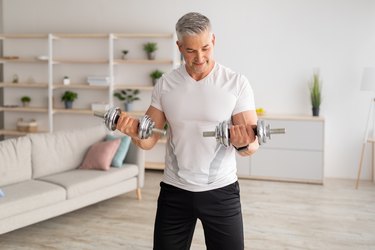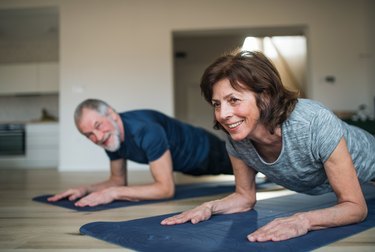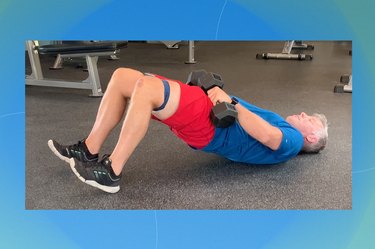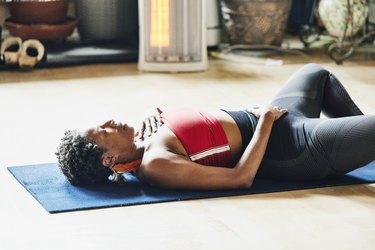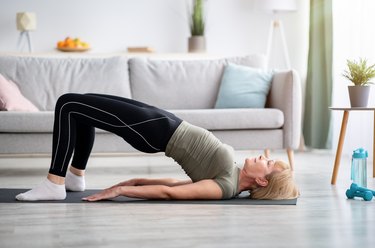

Some workouts may be harder on your joints as you age (think CrossFit, plyometrics and HIIT) but there's no reason to stop strength training in your 50s, 60s, 70s or beyond. Actually, as you get older, it's even more important to maintain a strength routine.
In the later decades of your life, it's normal to experience age-related muscle loss, especially through your lower body, according to Maria Delgado, CPT, a New York-based personal trainer with Blink Fitness. But this can make everyday activities (think: getting up from the floor) more challenging and potentially risky.
Video of the Day
Video of the Day
Following a lower-body strength routine can help you maintain as much muscle as possible and keep your body injury-free. This 20-minute all-levels-friendly workout is the perfect place to start.
Check out more of our 20-minute workouts here — we’ve got something for everyone.
Try This 20-Minute Workout for Your Legs and Butt
This lower-body workout contains five equipment-free moves, each targeting one of your body's fundamental movement patterns. To do the workout, do each exercise in order for the number of reps and sets listed below.
Move 1: Squat
Squats strengthen your quads, hamstrings, glutes, core and calves. But this move isn't only good for building muscle — it also helps guard against injury.
Whenever you sit down, you're doing a squat. And while plopping onto the couch probably isn't too risky, squatting down to pick up a heavy object can leave you achy if you have poor form. So, practicing this motion in your workouts can help prevent unwanted injury.
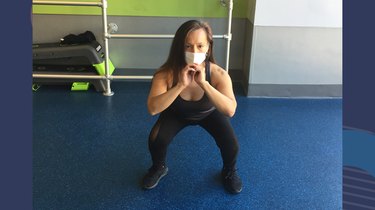
- Stand with feet hip-width apart, toes slightly turned out.
- Tighten your core and keep your chest up as you push your hips back and you lower your butt down and back.
- Continue to lower yourself until your thighs are almost parallel to the floor (or however far your mobility allows). Your feet should remain flat on the ground, knees tracking over your first or second toe.
- Drive through your heels as you press yourself back up to standing, finishing with a butt squeeze (but don't push your hips forward).
Move 2: Lateral Walk
Lateral walks are great for glute growth and also target your abductors (the muscles around your hips). Strengthening these muscles can help increase stability in your hips, taking pressure off your lower back while you exercise or do day-to-day activities.
Keep your steps slow and controlled to really engage these lower-body muscles. And if you want an extra challenge, you can place a resistance band around your ankles.
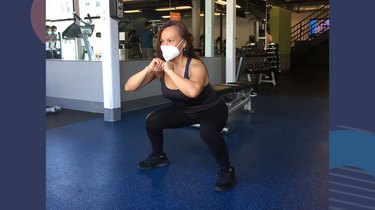
- Stand with your feet hip-width apart. Take a squat position, with feet grounded and hips pushed down and back.
- While squatting, take a wide step to the right with your right foot.
- Step your left foot toward your right until your feet are hip-width apart again.
- Take 4 small steps to the right, then repeat with 4 small steps to the left.
- Repeat for a total of 16 steps and complete 2 more sets.
Move 3: Side and Reverse Lunge
"These single-leg movements activate your stabilizing muscles, thus forcing your core and spine to work harder to develop balance, correct imbalances, and improve coordination and stability," Delgado says.
Front lunges aren't so friendly on your knee joints. Instead, stick with side or reverse lunges. Side lunges work your inner and outer thighs, training your body to move side to side. And reverse lunges put less stress on your knees, providing more stability in the front leg.
"They are ideal for those experiencing knee problems or difficulty balancing, as well as who have less hip mobility," she says.

- Stand with feet shoulder-width apart, toes pointed straight forward.
- Step out to the right side with your right foot.
- Drop your hips down and back while keeping your left leg straight, continuing to point toes forward. Make sure your right knee is tracking over your right foot.
- Press through the right heel to push yourself back to standing.
- Take a big step backward with your right foot until both knees reach a 90-degree angle. Your back knee should hover just about the ground and your front knee shouldn’t go beyond your toes.
- Lift your front leg and return to standing.
- Do 5 reps (1 side lunge + 1 reverse lunge = 1 rep) on each leg and complete 3 sets total.
Move 4: Glute Bridge
Glute bridges strengthen your glutes and hamstrings. "This exercise can also improve core stability by targeting your abdominal muscles and the muscles of lower back and hip," Delgado says.
Another bonus? This one move is accessible for all fitness levels. Since this move is a lying-down, single-joint exercise, you don't need too much coordination to do it with good form (and enjoy muscle-building benefits), according to an April 2017 study in the Journal of Strength and Conditioning Research.
For added tension and more glute burn, place a resistance band around your thighs or hold the top of the exercise for a few extra seconds.
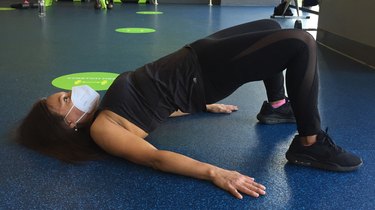
- Lie on your back with knees bent and pointed to the ceiling.
- Exhale and lift your butt off the floor. Keep both feet grounded on the floor and your thighs and feet parallel. Your body should form a straight line from your shoulders to your knees.
- Rest your arms with hands palms down by your sides or clasp them together and extend them along the floor beneath you.
- Squeeze your glutes tightly and hold the contraction for 3 seconds.
- Release and lower your butt to the floor and repeat.
Move 5: Quadruped Side and Back Kick
Also known as a donkey kick, glute kicks focus in on your glutes, more specifically the gluteus maximus (the middle part of your glute) and minimus (the lower part of your glute).
"The side kick works particularly the quads, glutes, outer thighs and core," Delgado says. "The back kicks or butt kicks work the hamstrings and glute muscles, which will help shape the buttocks and strengthen it."
Imagine leading the kick motion with your knees to give your glutes a better squeeze at the top.
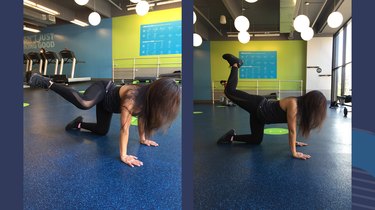
- Get on all fours, keeping your ab muscles tight.
- With your right knee bent, lift it out to the side until it's parallel to the floor.
- Hold for 2 seconds, then bring it back to starting position.
- Then, keeping the right knee bent, lift it up toward the back until your foot is parallel to the ceiling.
- Hold for 2 seconds, then bring back to starting position.
- Repeat for 20 reps (10 side kicks and 10 back kicks), then switch legs.
- Complete 3 sets total.
Additional reporting by Bojana Galic.
